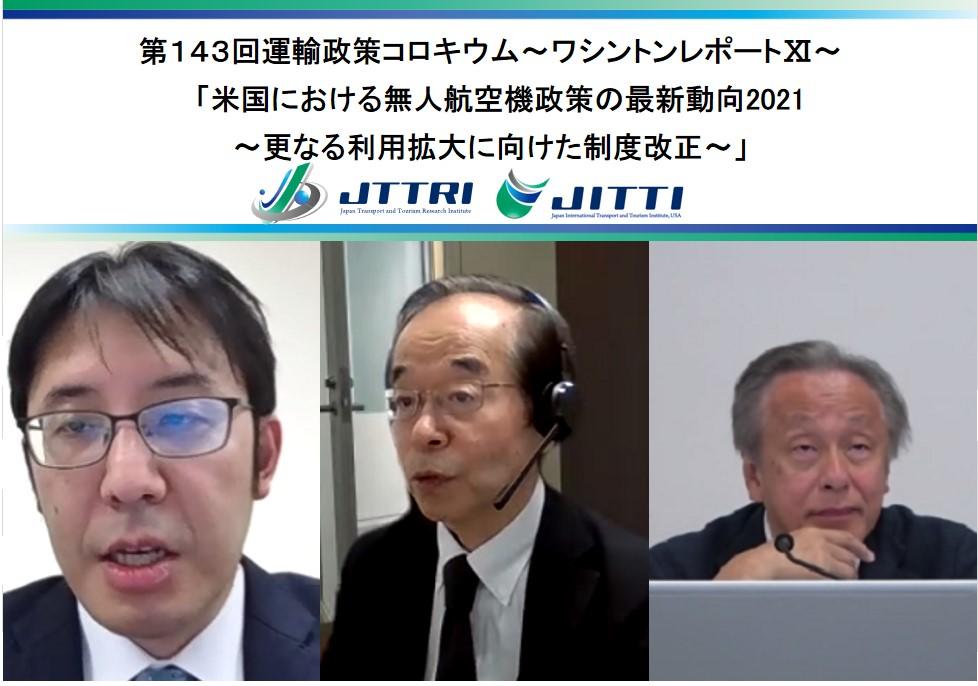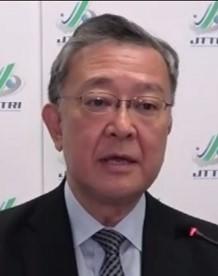The Latest Trends in UAS Policy in the United States, Edition 2021 - Revision to the regulations for further expansion of use -
- Colloquium
- Aviation and Airport
- New Technology and Innovation
The 143rd Transport Policy Colloquium -Washington Report Ⅺ-(Online)※Language : Japanese


| Date / Time | Tue, Sep 21,2021 10:00-12:00 |
|---|---|
| Event Number | The 143rd |
| Theme | The Latest Trends in UAS Policy in the United States, Edition 2021 - Revision to the regulations for further expansion of use - |
| Lecturer | Lecturer:FUJIMAKI Yoshihiro Senior Research Fellow, Japan International Transport and Tourism Institute, USA (JITTI USA) Commentator:SUZUKI Shinji Project Professor, Institute for Future Initiatives, the University of Tokyo - Q&A session - Coordinator:YAMAUCHI Hirotaka President for Research, Japan Transport and Tourism Research Institute (JTTRI) |
Event Summary
Regardless of the COVID-19 pandemic, the use of small Unmanned Aircraft Systems (UAS) for commercial and public purposes continues growing. In order to support the expansion of these uses, revisions to the regulations of UAS operations are underway in many countries. In the US, two important regulations were published in January 2021: one for Remote ID and the other for operations at night and over people. In this colloquium, as the latest trends in the US, the details of these two new regulations and the trend of revising the regulations to expand the Beyond Visual Line of Sight (BVLOS) operations were presented. After that, Prof. Suzuki of the University of Tokyo’s Institute for Future Initiatives, who is a leading expert on aviation innovative technologies including unmanned aerial systems, was invited as a commentator to introduce the regulations in Europe and discuss issues and measures for further expansion of use. The colloquium was a great success with 446 participants from universities and other research institutes, government offices, and airline companies.
Program of the seminar is as the following
| Opening Remarks |

SHUKURI Masafumi |
|---|---|
| Lecturer |

FUJIMAKI Yoshihiro |
| Commentator |

SUZUKI Shinji |
| Coordinator |

YAMAUCHI Hirotaka |
| Closing Remarks |

OKUDA Tetsuya |
Outline of the seminar
Fujimaki, Senior Research Fellow at the Japan International Transport and Tourism Institute, USA, gave a presentation on the theme: The Latest Trends in Unmanned Aircraft Systems Policy in the United States, edition 2021 — Revision to the Regulations for Further Expansion of Use — The following are the key points of that presentation.• Unmanned Aircraft Systems (UAS) are broadly divided into three categories: those used for recreation such as model airplanes, those in commercial use such as for aerial photography and surveying, and those in public use such as for assessing the situation from the air when there has been a disaster. Although the number of recreational UAS has increased during the coronavirus pandemic, it is expected to reach saturation in the near future. Conversely, although the numbers of commercial and public UAS are below the pre-coronavirus forecast, the numbers of commercial and public UAS are expected to increase in the future.
• As a regulation for registering and identifying UAS in the United States, until now, the registration using the online system and the display of the identification number on the UAS were required by the regulation for registering and identifying UAS, which was released in 2015. However, because it is not possible to identify flying UAS by displaying an identification number on the UAS, the regulation on remote ID that enable remote identification was released in 2021.
• Also, in principle, as a regulation relating to night operation and operation over people by commercial UAS in the United States, night operation and operation over people are prohibited according to the rules on commercial UAS, which were released in 2016, and these operations were conducted after obtaining individual approval based on an application for waiver from the regulation. In response to the regulations related to night operation and operation over people in the rules related to commercial UAS, the regulation for night operation and operation over people was released in 2021 to eliminate the need to apply for waiver from the regulations when certain safety standards have been met.
• For recreational UAS, certain flights are permitted without individual application, provided that safety guidelines are followed. However, in view of significant changes in the environment in recent years, both in terms of UAS and pilots, a knowledge test (TRUST) for pilot was implemented from June 2021. Plots have to pass this knowledge test.
• There are three methods for complying with the regulation on remote ID. Those are: "Standard Remote ID" for incorporating functions into new UAS; "Remote ID Broadcast Module" for attaching modules with functions to existing UAS and home-made UAS, and "FAA-recognized flight area (FRIA)" for flying without a remote ID in limited areas. Furthermore, for UAS manufactured after September 16, 2022 (manufacturing cutoff date), it is mandatory to follow the standard remote ID method, and after September 16, 2023 (operating cutoff date), it is mandatory to fly an UAS using one of the three methods mentioned above.
• The regulation for night operation and operation over people requires knowledge to be given to pilots and collision-prevention lights to be installed when flying at night. Also, in the case of operation over people, requirements are set for each category after classifying small UAS into four categories (categories 1 to 4) according to the risk in the event of a crash. Approval from the FAA are not required for Category 1 UAS with a total weight of 250 grams or less. However, for Category 2 and Category 3 UAS with a total weight of more than 250 grams, approval by the FAA is required based on declaration of compliance to the requirements. Furthermore, if the kinetic energy of the impact exceeds the threshold of Category 3, airworthiness certification of the UAS is required as Category 4.
• For beyond visual line of sight (BVLOS) operations, the number of applications for waiver from the regulation is approximately 3,000, while the number of approvals is only a small number. Furthermore, only three companies have been authorized to conduct transporting small cargoes for compensation in BVLOS operations. Implementation of a new demonstration project (BEYOND) and consideration by the Advisory Committee (UAS BVLOS ARC) are underway for the expansion of these BVLOS operations.
• In addition to the review relating to the operation method mentioned above, the formulation of safety standards for type certification for each of UAS type, which is a premise for UAS airworthiness certification, measures for the use of remote ID information for the future airspace integration with manned aircraft, and a change to gender-neutral terminology from gender-specific terminology relating to UAS, are all currently under consideration.
• In Japan, under the revised Civil Aviation Act established in June 2021, it will be possible to conduct BVLOS operations over people, but in addition to UAS certification, individual approvals are required. In the United States, the number of BVLOS operations that require waiver from the regulation is limited to a small number of such approvals. For that reason, in order to fully expand BVLOS operations over people, it is considered necessary to continuously review the rules based on individual approvals and the results of demonstration projects, and to make general rules that do not depend on individual approvals.
• Furthermore, although a gender bias exists in human resources in the aviation industry, it is necessary to improve the diversity of human resources in order not only to respond future demand for further human resources but only to make innovations to maintain and expand leading position in the world. In particular, it is necessary to implement educational initiatives from an early stage to determine future careers.
Subsequently, the commentator, Professor Suzuki of Institute for Future Initiatives of the University of Tokyo, gave the following explanation and asked questions.
[Explanation]
In Europe, regulations relating to UAS were instituted in each country, but the EU regulation in 2019 was established to integrate regulations in EU member states (including Switzerland, Norway, and others), and to classify civil UAS into three categories according to their risk, namely Open, Specific, and Certified. A feature of this EU Regulation is that it distinguishes between the role of the operator and the role of the pilot (remote pilot).
The "Open" category relates to operations that are made at an altitude up to 120 m without approval, but those operations are further classified into sub-categories A1 to A3 based on the weight of the UAS and the proximity to any third parties and third-party property. The requirements for UAS capable of flying the respective sub-categories are set as C0 to C4 UAS classes. UAS registration nor pilot training and testing are not required for the C0 class with an UAS weight less than 250 grams. However, UAS registration, and pilot training and testing are required for C1 to C4 classes with an UAS weight of 250 grams or more. In particular, theoretical examination in each country is required for C2 class UAS pilots flying near people in the A2 sub-category.
In the "Specific" category, when flying with more risk than "Open" category, such as operations at an altitude of 120 m or higher, BVLOS operations, or operations at an altitude up to 120 m above urban areas using UAS with a weight of 4 kg or more, it is necessary to conduct a risk assessment individually and obtain approval for the operation. However, when flying an UAS that meets the requirements (C5 or C6 class) of the UAS that corresponds to the standard operating scenario, operation is possible without conducting individual risk assessment. Two standard scenarios are established: operations at an altitude up to 120 m above urban areas using UAS with a weight of 4 kg or more, and BVLOS operations at an altitude up to 120 m and within 2 km of the pilot. Furthermore, in the case of standard scenarios, pilots must be licensed through training and testing corresponding to the relevant scenarios. In other scenarios, it is necessary to individually propose a training course and obtain an approval from a competent authority, and to let pilots engage in that training. Pilot licensing may be conducted by the organizations that have been approved to issue such license by the aviation authority in each country.
The “Certified” category is a category in which an approval of the operator, a certification of the UAS and a license of the pilot are all deemed to be necessary because of the high risk, but the details are under consideration.
[Questions]
(1) Does the FAA require practical skills test as well as knowledge test for operations over people, night operations, and so on?
(2) With regard to the FAA category 4 type certification, it seems that a method for emphasizing aircraft level testing rather than processed approach, which is used for manned aircraft, is being considered. On this point, is the discussion between countries for international harmonization moving forward?
(3) How is the general public accepting this, such as operation over people and night operations? Also, besides safety concerns, what about noise, privacy and security concerns?
Senior Research Fellow Fujimaki responded to these questions as outlined below.
(1) In order to comply with the enforcement of the regulation for night operation and operation over people, the contents of the test for pilots of UAS have been revised. However, the contents continue to be a knowledge test only and a practical skills test is not required.
(2) In the proposed safety standards for type certification, the FAA introduced the approach of "Durability and Reliability (D&R)", which demonstrates reliability by testing at the aircraft level. Although Special Condition Light UAS (SC-Light UAS) itself, safety standards established by the European EASA in December 2020, does not describe the D&R approach, a policy to allow the D&R approach as a method of showing compliance with safety standards is stated in the published response to comments, and discussions are moving forward towards harmonization.
(3) While there are thousands of cases of night operations approved for waiver from regulations, major concerns have not been heard from the general public. This reason is considered that the range within which UAS can fly with sight is narrower at night than during the day, and the effect is limited.
With regard to operations over people, the number of approved waivers from the regulation is small, and the approval of UAS of categories 2 to 4 after regulatory revision will start from now. As a result, concerns may arise with the increase in the number of operations in the future. Conversely, it is believed that the mandatory use of remote ID will act to suppress operations over people with low necessity. At the federal level, there is few efforts such that the National Telecommunications and Information Administration (NTIA) presents best practices of how to respond to privacy, transparency, and accountability concerns with regard to UAS operations. Lastly, we received questions from audiences, and further discussions were held regarding traffic control relating to UAS, details of information transmission by remote ID, operation controls including risk management, and the approval of organizations associated with issuing pilot licenses.


